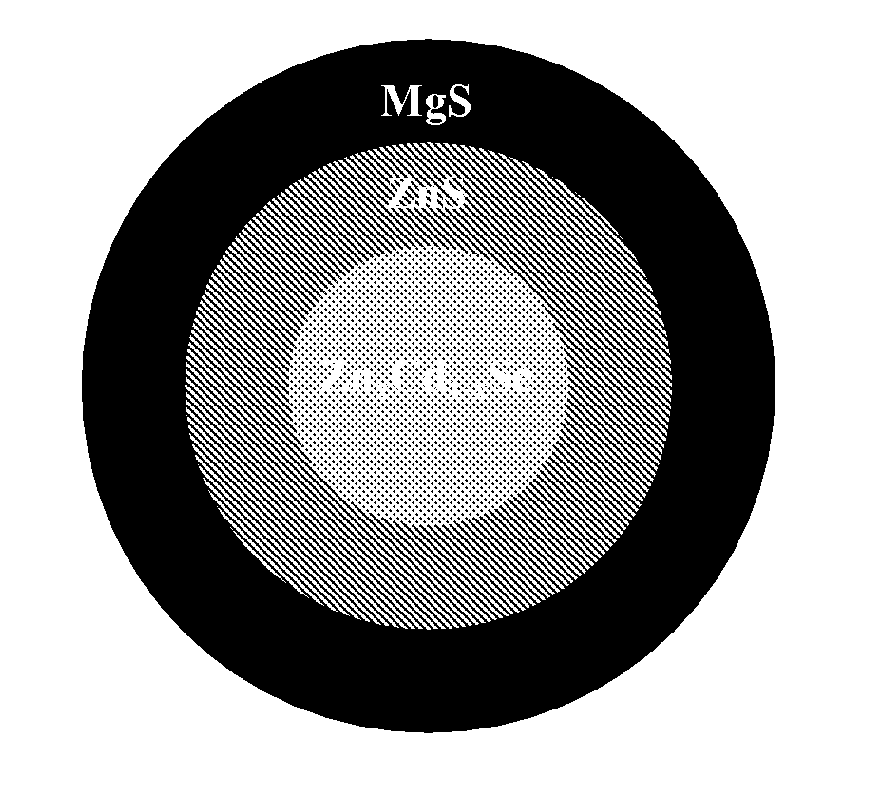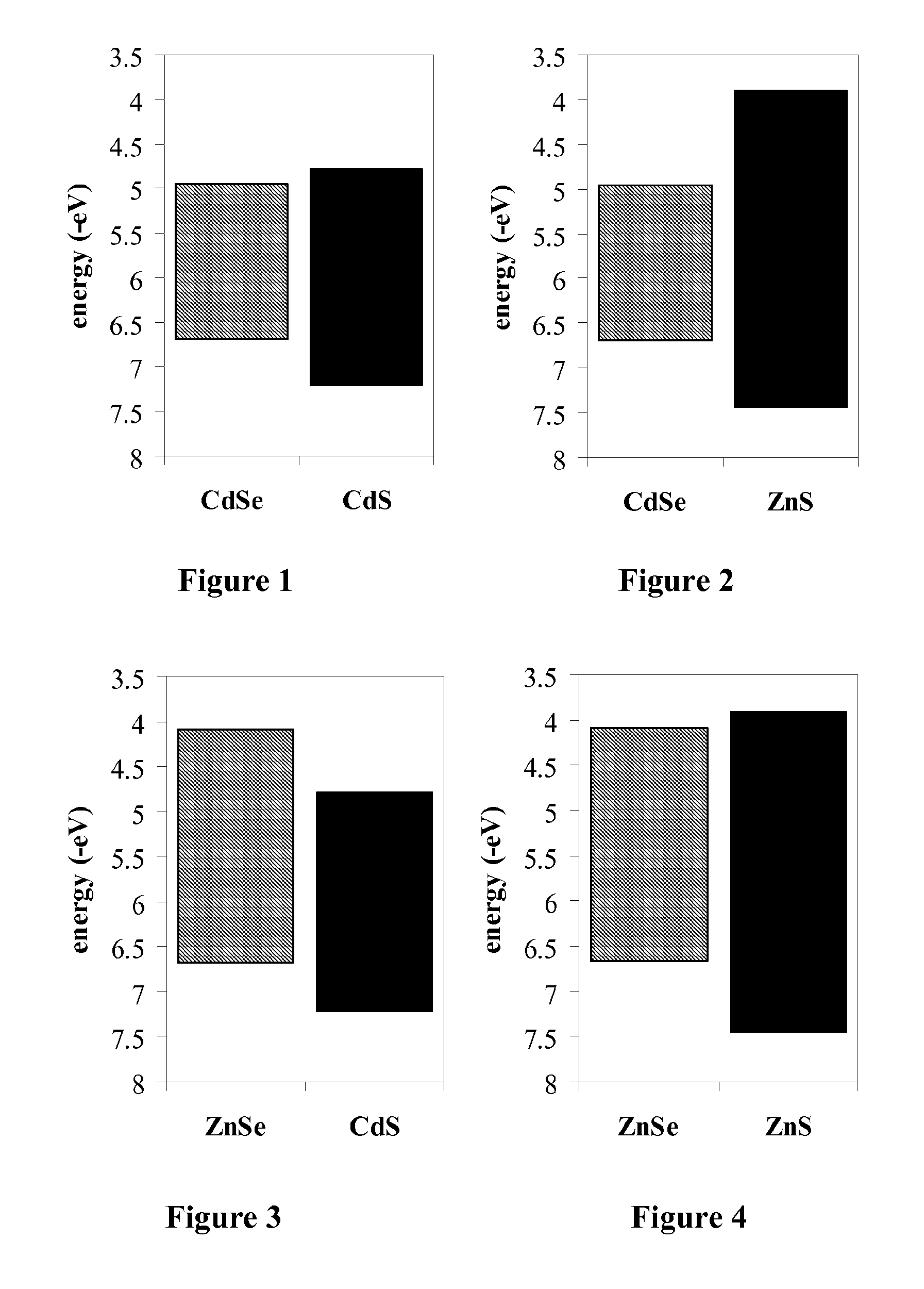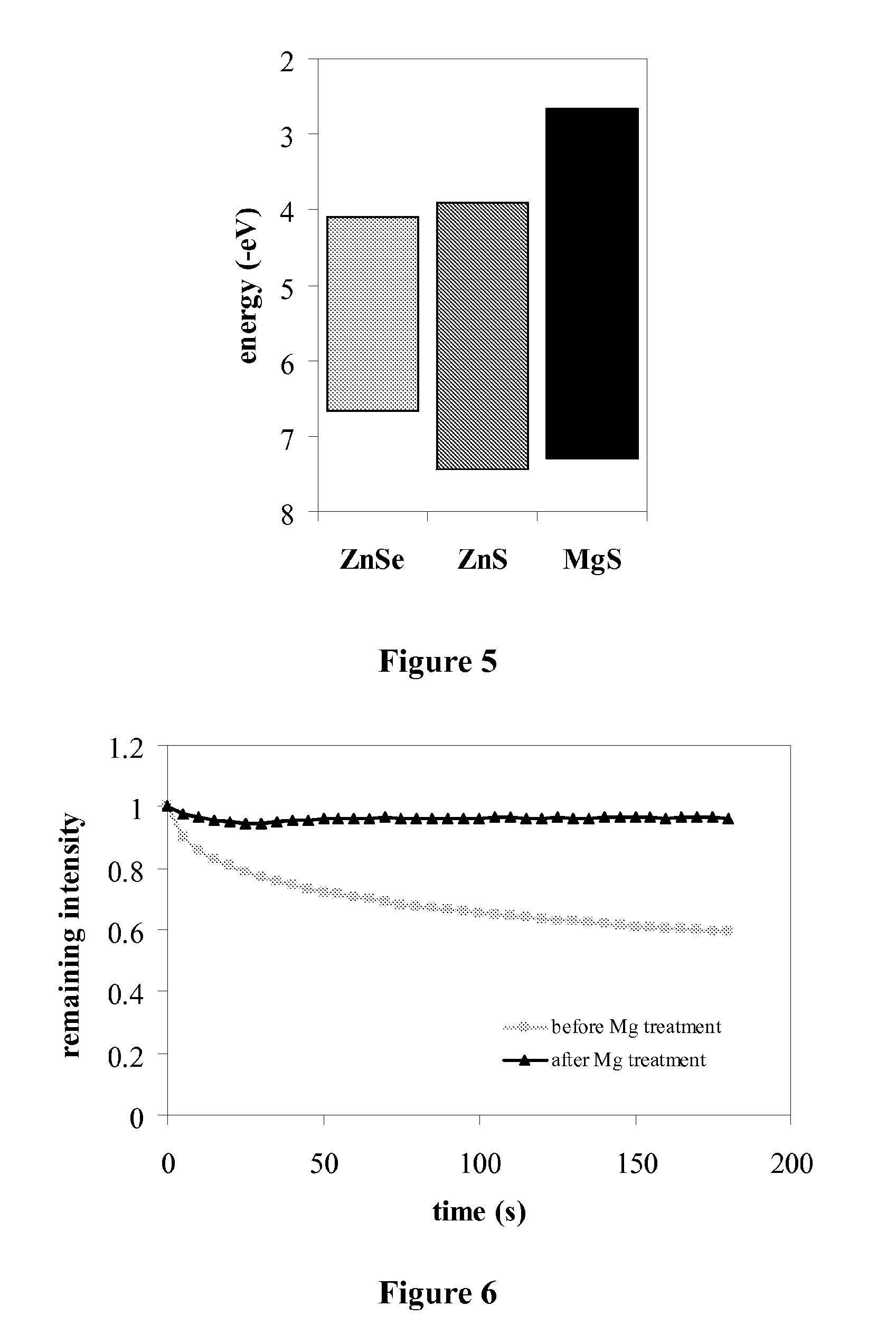Magnesium-based coatings for nanocrystals
a technology of magnetism and nanocrystals, applied in the field of magnetism-based coatings for nanocrystals, can solve the problems of incomplete destruction of the luminescence of nanocrystal cores, lack of intense or stable emission intensities of nanocrystal cores alone, and inability to predict bandgap properties of thin layers of semiconductor materials forming a shell on nanocrystals, etc., to achieve the effect of increasing the phototability of nano
- Summary
- Abstract
- Description
- Claims
- Application Information
AI Technical Summary
Benefits of technology
Problems solved by technology
Method used
Image
Examples
example 1
Preparation of Luminescent ZnSe Nanocrystal Cores
[0160]To a 50 mL round bottom reaction flask under inert atmosphere, 15 mL of molten hexadecylamine, 98% and 47 μL of Bis(2,4,4,-trimethylpentyl) phosphinic acid (CYANEX 272 from Cytec Industries Inc) were added. The mixture was heated to 100° C. under vacuum while stirring and held for 15 minutes. After the 15 minute hold time, the flask was refilled with nitrogen and further heated to 310° C. At 310° C., a mixture of 0.123 g (1.0 mmol) diethylzinc (Et2Zn) and 1.274 g of 1 M TOP-Se (1.4 mmol Se) (TOP-Se was prepared by dissolving selenium metal in trioctylphosphine) was swiftly injected into the flask. After a 15 minute hold time, an additional syringe of 0.370 g Et2Zn (3.0 mmol of Zn) and 3.822 g of 1 M TOP-Se (4.2 mmol of Se) was prepared and added at a rate of 18.5 μL / minute for 15 minutes, 50 μL / minute for 30 minutes and 75 μL / minute for 15 minutes. When the precursor addition was completed, the reaction was cooled to room temper...
example 2
Preparation of Luminescent ZnSe Nanocrystal Cores
[0161]To a 50 mL round bottom reaction flask under inert atmosphere, 15 mL of molten hexadecylamine (HDA), 98% was added. The HDA was heated to 100° C. under vacuum while stirring and held for 15 minutes. After the 15 minute hold time, the flask was refilled with nitrogen and further heated to 310° C. At 310° C., a mixture of 0.123 g (1.0 mmol) diethylzinc (Et2Zn) and 1.274 g of 1 M TOP-Se (1.4 mmol Se) (TOP-Se was prepared by dissolving selenium metal in trioctylphosphine) was swiftly injected into the flask. After a 15 minute hold time, an additional syringe of 0.370 g Et2Zn (3.0 mmol of Zn) and 3.822 g of 1 M TOP-Se (4.2 mmol of Se) was prepared and added at a rate of 18.5 μL / minute for 15 minutes, 50 μL / minute for 30 minutes and 75 μL / minute for 15 minutes. When the precursor addition was completed, the reaction was cooled to room temperature. The final material had an emission maximum wavelength of 413 nm and a FWHM of 19 nm. The...
example 3
Preparation of Luminescent ZnCdSe Nanocrystal Cores
[0162]To any given volume of molten ZnSe cores as prepared in Example 1, 6 volumes of toluene followed by 2 volumes of butanol were added. After thoroughly mixing this mixture, 7 volumes of methanol were added. The cloudy mixture was centrifuged at about 3000 rpm for 10 minutes. The supernatant was discarded and 1 volume of hexane was added to dissolve the nanocrystal-containing pellet. The concentration of the hexane solution was determined by measuring the absorbance at the first absorbance feature and dividing by the extinction coefficient. The extinction coefficient was calculated with the following equation, where the particle diameter was measured by TEM.
∈=4.8080×(particle diameter in angstroms)3
[0163]To a 50 mL round bottom reaction flask under inert atmosphere, 6.3 mL of molten hexadecylamine and 163 nmoles of ZnSe cores in hexane (from above) were added. The flask was held under vacuum until all volatile solvents were remo...
PUM
 Login to View More
Login to View More Abstract
Description
Claims
Application Information
 Login to View More
Login to View More - R&D
- Intellectual Property
- Life Sciences
- Materials
- Tech Scout
- Unparalleled Data Quality
- Higher Quality Content
- 60% Fewer Hallucinations
Browse by: Latest US Patents, China's latest patents, Technical Efficacy Thesaurus, Application Domain, Technology Topic, Popular Technical Reports.
© 2025 PatSnap. All rights reserved.Legal|Privacy policy|Modern Slavery Act Transparency Statement|Sitemap|About US| Contact US: help@patsnap.com



